|
|
|
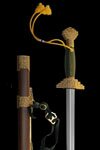 |
|
| Imperial Qing Sword (Tien Di Ren Jian) (DF030) |
Points: 20

|
The Imperial Qing Sword is based on a historical piece designed and commissioned in 1748 by the Qian Long Emperor (Qing Dynasty) for members of the royal family. This sword was part of a series of 30 pieces, sorted into 3 categories: Heaven (Tian), Earth (Di), Man (Ren). The blade is decorated with an intricate fretwork design and forged from Dynasty Forge's forge-folded 1095/1085/1060 high-carbon steel. The sheath is hand-carved from hardwood while the handle features a hardwood core wrapped in green cord.
|
|
|
|
|
|
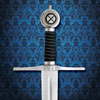 |
|
| Medieval Sword of Robert the Bruce (501495) |
Points: 10

|
Medieval Sword of Robert the Bruce. Inspired by the King of the Scots, Robert the Bruce, this sword has the Cross of St. Andrew set in the pommel. Hand forged 1065 high carbon steel comprises the blade. Overall: 43-1/2″ this sword dates circa 1300 and is made as seen in the film Robert the Bruce!
|
|
|
|
|
|
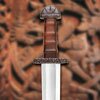 |
|
| Ashdown Viking sword (501561) |
Points: 10

|
Ashdown Viking sword. The cross guard is richly decorated with raised knots. Both the guard and the head are made of steel and have been darkened to give an antique finish. Soft leather covers the wooden handle. The set includes a leather scabbard with a matching belt, which has a very decorative metal fitting.
|
|
|
|
|
|
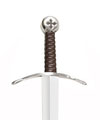 |
|
| Malta Sword of the Knights of St John 1565 (501226) |
Points: 10

|
The St. John's Knights Sword is also called the sword of Malta in memory of the fierce battle during the siege of Malta, in which the Knights of Saint John stopped the huge Ottoman flotilla from further entering their territory.
|
|
|
|
|
|
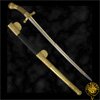 |
|
| Hanwei Charlemagne Saber (SH2288) |
Points: 30

|
The "Saber of Charlemagne the Great" is a vital part of European history, being an important artifact in the Insignia of the Holy Roman Empire, of which Charlemagne was the first Emperor. The saber is housed today, together with the rest of the imperial insignia, in the Kunsthistoriches Museum in Vienna. The sword is of Eastern European origin, dating from the first half of the 10th century. How it became a part of the insignia is not known but its lavish decoration indicates that it was made for an important member of the nobility. It is clearly a cavalry saber, indicative of its origins in the Eurasian Steppes.
CAS Hanwei's version of the saber is faithful in detail to the weapon as it was conceived, even to the point of omitting the decorative 15th century repairs that render the original unusable.
|
|
|
|
|
|
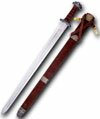 |
|
| Godfred Viking sword (SH1010) |
Points: 24

|
Godfred Viking sword named for the feared 8th century Viking raider, our Godfred Sword (SH1010) is built around a beautifully patterned folded steel blade to replicate the pre-9th century originals. The interwoven leather grip, complemented by a Damascus guard and pommel, is matched by the leather-covered wood scabbard with bronze detailing and integral belt hooks. Superbly balanced, due to the deeply fullered distal tapered blade profile, the Godfred is a true tribute to the legendary Norse smiths.
Interwoven leather grip
Damascus guard and pommel
Leather-covered wood scabbard with bronze detailing and integral belt hooks
|
|
|
|
|
|
 |
|
| Hand-and-a-Half Sword (SH2034) |
Points: 20

|
Replicated from a sword thought to be that of Albrecht II of Austria, the Hand-and-a-Half Sword (SH2034) represents the pinnacle of beauty and balance in medieval swords. Classically simple in design with a flattened diamond-section blade and cruciform hilt, the original dates from the early part of the 15th century. The Lion Rampant emblem of the Habsburg dynasty is engraved in the pommel, while the Passau Running Wolf guild mark and a marigold maker`s mark appear on the blade fuller. Both the grip and the scabbard are leather covered over a cord wrap.
Authentic replica of Museum Piece
Fully functional
Excellent handling and balance
|
|
|
|
|
|
 |
|
| Hanwei Scottish Claymore (SH2060) |
Points: 12

|
Mainstay of the Highland warriors of the late 15th and 16th centuries, the Claymore had a uniquely styled hilt that sets it apart from other great swords of the period. Typically of hand-and-a-half length, this versatile weapon could deliver great sweeping slashes or powerful thrusts. Replicated from a surviving museum piece our Claymore (SH2060) is classic in its design, with distinctive sloping quillons terminating in quatrefoils and a high-collared quillon block with langets following the blade fuller. The leather-covered grip is topped by a globate pommel. Originally carried slung on the back, the Claymore matches perfectly with our OL1038B back scabbard.
Authentic styling
Fully functional
Excellent balance
|
|
|
|
|
|
 |
|
| ''Lowlander'' Two-Handed Great Sword (SH2065) |
Points: 14
|
Wielded with untamed ferocity on many a Gaelic battlefield, the massive Lowlander sword vividly illustrates the might of the Scots of old. Known as Slaughter-Swords in the 16th century, these were the swords of choice for Scottish mercenaries of the period, and at close to six feet long the Lowlander (SH2065) faithfully replicates a surviving museum piece. Though by far the largest sword ever offered by CAS/Hanwei, the Lowlander is beautifully proportioned and balanced. The typically Scottish quatrefoils in the ring guards attest to the heritage of this imposing piece. A wall mount is provided to allow the transplanted Gael to display his sword with pride.
Almost 6' long
Fully functional
Wall mount included
|
|
|
|
|
|
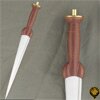 |
|
| Hanwei Scottish Dirk (SH2363) |
Points: 8
|
The ever-popular Early Dirk is strikingly authentic, its clean lines and carved hardwood hilt making it a clansman re-enactor favorite. Iberia Swords are crafted in much the same way as swords were made centuries ago, except that the blades are now forged from high-carbon spring steel, a resource unavailable off-the-shelf to the smiths of the old. The blade finish is far from being polished, again more closely replicating what the medieval swordsmith was able to achieve. Except as noted, grips are leather-covered hardwood. Fittings are either steel or solid brass. Except, where shown all of these swords have scabbards of leather-covered fiberglass with steel lockets and chapes and removable suspension rings. These swords will appeal to the re-enactor who wants a sword with the same appearance as the originals.
|
|
|
|
|
|
 |
|
| Templar Dagger (SH2364) |
Points: 7
|
The Templar Dagger is a solid sidepiece. Its solid brass fittings and black leather scabbard will complement period garb beautifully. Iberia Swords are crafted in much the same way as swords were made centuries ago, except that the blades are now forged from high-carbon spring steel, a resource unavailable off-the-shelf to the smiths of the old. The blade finish is far from being polished, again more closely replicating what the medieval swordsmith was able to achieve. Except as noted, grips are leather-covered hardwood. Fittings are either steel or solid brass. Except, where shown all of these swords have scabbards of leather-covered fiberglass with steel lockets and chapes and removable suspension rings. These swords will appeal to the re-enactor who wants a sword with the same appearance as the originals.
|
|
|
|
|
|
 |
|
| Hanwei Scottish Court Sword (SH1214) |
Points: 12

|
Quick and elegant describe the Scottish Court Sword. Replicating an original dating from the 1730's and belonging to an officer in Prince Charles Edward Stuart's army at Culloden, the finely chiseled silver-plated hilt and three-edged hollow ground blade exemplify the consummate skill of the swordsmiths of the period. See model SH2324 for the Practical Fencing Court Sword.
|
|
|
|
|
|
 |
|
| Hanwei Scottish Basket Hilt Broadsword (SH2002) |
Points: 15
|
Although Basket-Hilt swords appeared throughout Britain from the mid-sixteenth century on, their association with the seventeenth and eighteenth century Scottish highlander has become legendary.
Our Basket-Hilt Broadsword, replicated from an original in the collection of the Royal Armouries in England, carries a typical Glasgow-style hilt from the mid-18th century. It is likely that the blade of the original sword, marked "Andrea Ferara", was made in Germany a century earlier and re-hilted as basket designs were refined.
|
|
|
|
|
|
 |
|
| Hanwei Scottish Basket Hilt Backsword (SH2003) |
Points: 24
|
Early highland swords almost invariably carried the double-edged "broadsword" blade, but by the time of the Battle of Culloden (1746) the single-edged "backsword" was at least equal in popularity.Our Basket-Hilt Backsword, replicated from an original in the collection of the Royal Armouries in England that dates from about 1760, has an unusual basket with twin engraved "horned beastie" plaques and a blade with twin fullers running most of its length. The blade is German in origin, but the hilt and blade are contemporary.
|
|
|
|
|
|
 |
|
| Hanwei Scottish Claymore (SH2060N) |
Points: 18
|
Mainstay of the Highland warriors of the late 15th and 16th centuries, the Claymore had a uniquely styled hilt that sets it apart from other great swords of the period. Typically of hand-and-a-half length, this versatile weapon could deliver great sweeping slashes or powerful thrusts. Replicated from a surviving museum piece our Claymore is classic in its design, with distinctive sloping quillons terminating in quatrefoils and a high-collared quillon block with langets following the blade fuller. The leather-covered grip is topped by a globate pommel. The sword is available in both polished and antiqued finishes, the finish of the SH2060N closely replicating that of the original museum piece. The grips of the Claymore are leather-covered, black in the case of the SH2060 and brown for the SH2060N. Originally carried slung on the back, the Claymore matches perfectly with our OL1038/OL1038B back scabbard.
|
|
|
|
|
|
|
|
Tags:
swords, sword, katana, wakizashi, tanto, japanese sword, medieval sword, viking sword, japanese swords, medieval swords, viking swords, knife, knives, saber, armour, movie swords, movie replicas, martial arts, sporting goods, sporting equipment,
|

















